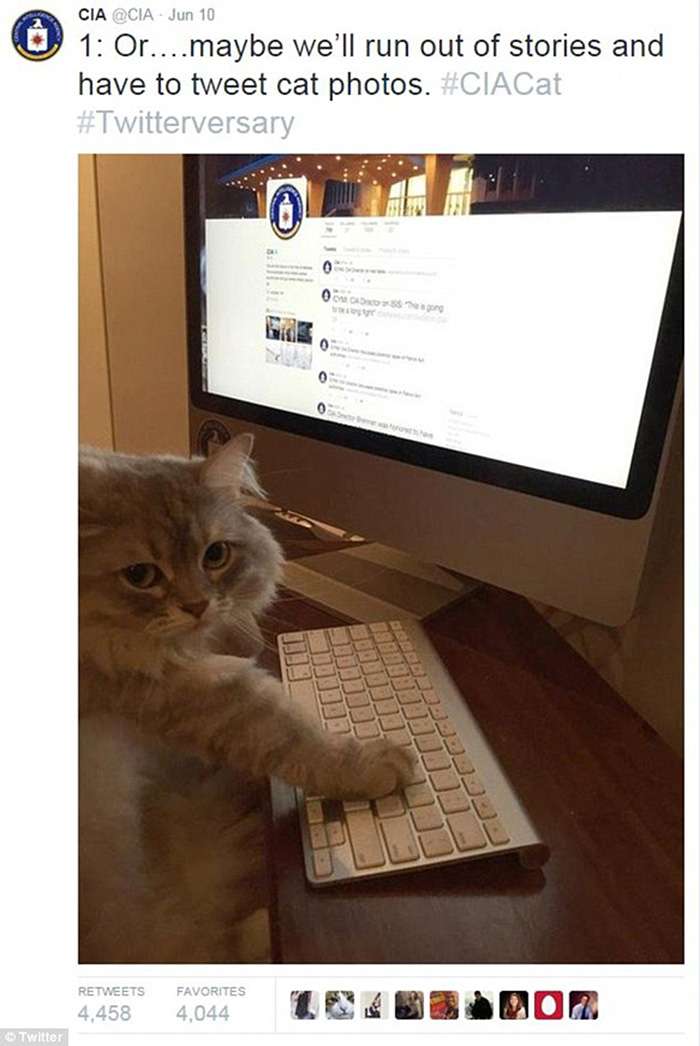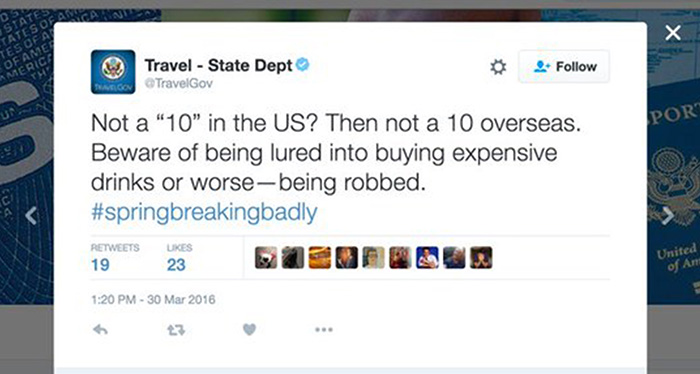Digital Diplomacy: Will State Ever Take the Plunge?
Speaking Out
BY AMELIA SHAW
When I came into the State Department in 2014, I was excited to add my skills to our country’s public diplomacy (PD) effort. I brought with me 15 years of media experience, and imagined entering a cutting-edge operation, where highly skilled teams use technology and innovation to promote our national foreign policy to publics abroad.
But that’s not what I found. Instead, it feels more like being stuck in a time warp from the late 1990s.
Here’s what I mean. I recently took six weeks of training in preparation for my first assignment as a PD officer, in Vientiane. During our 180 hours of class time, we talked about a lot of things—the history of the U.S. Information Agency, the legacy of Edward R. Murrow and the meaning of PD. But we spent just three hours on digital media—less than 2 percent of total training time.
I was shocked. While our bureaucracy has been busy plugging away at statecraft, the rest of the world has undergone a digital revolution. Has State even noticed?
As of December 2016, there are about 3.4 billion people using the internet worldwide—47 percent of the global population—with just over half of them using Facebook.
Due to the breakneck speed of mobile phone penetration into the developing world, the number of people online is expected to continue to rise steadily. Increasing numbers of users are younger than 30 and live in developing or transitional economies in Asia, Africa and Latin America.
Many of us Foreign Service types live and work in those places. But are we present there virtually? And are we making the most of the huge (not to mention relatively low-cost) opportunity that digital media offer our diplomatic missions in our quest to win the hearts and minds of the foreign public?
Many leading analysts would answer with an emphatic no.
Jets Don’t Go on Highways
“The U.S. government is appalling at giving diplomats the leeway to use technology as it is intended,” says Nicholas Cull, director of public diplomacy at the Annenberg School for Communication and Journalism (part of the University of Southern California). Cull has advised the State Department for years on PD issues and lectures regularly at the Foreign Service Institute.
“You can’t drive a jet on a highway. Digital platforms were designed to create relationships, not just push messages out,” Cull adds. “The average U.S. embassy Facebook page makes it look like the U.S. government doesn’t understand the business of public diplomacy.”
Cull is referring to the practice among many U.S. missions of using Facebook as a signboard on which to cut and paste media content created in Washington or post drab “LOPSA” (lots of people standing around) photos. Either way, too often content is placed without considering how it resonates locally. Your average Nepali, for instance, might not be interested in a post about the kinds of vegetables planted in the White House kitchen garden.
There are, of course, missions that stand out for successfully using social media to create local buzz. Embassy Moscow’s 2015 tweet about the U.S. ambassador landing on the moon is a great example of dishy repartee with Russia’s dezinformatsiya or fake news apparatus. But these efforts tend to be the exception, not the norm.
Compared to other Web and Facebook pages, U.S. mission digital platforms generally experience low traffic. Online users who do follow the U.S. pages rarely comment; and when they do, they almost never get an answer from an actual American diplomat.
In the digital age, that kind of silence is fatal. It’s also an indictment of our PD presence online, which misses the entire point of social media: engagement.
Engagement is the conversation that happens between followers on Web platforms; it’s more than a “like” or a “share.” Engagement is access, influence, conversation and communities of interest that form around a particular issue. It’s empowerment.
Unless the State Department starts engaging with foreign publics online, how can we hope to be part of the global conversation—much less influence what non-Americans think and do?
Digital Diplomacy—Not All That Quick or Easy
There are a number of structural constraints holding back State’s public diplomacy efforts in the digital arena. The first of these is time. Skill, tools and technical know-how are additional constraints.
Back in my TV days, every minute that went to air took two to three hours to produce. In other words, a three-minute news segment took, on average, six to nine hours to make. Understaffing of digital operations at State exacerbates this problem. Posts with tight resources tend to invest staff time in the traditional programming that has defined the PD field since the heyday of the U.S. Information Agency, rather than in social media.
Many PD shops are small to begin with, and sometimes have just one local employee whose job is to “do social media.” These employees may not have a media background and are also likely to be juggling other responsibilities, such as managing the education portfolio. Even if they are able to post a few times a day on social media platforms, they’re severely limited when it comes to creating original content or engaging with followers.
Bigger posts may have more PD officers and local staff who can divide up the work by function. Some missions even have the luxury of hiring media-savvy local staff who are wholly devoted to creating media content. This is a huge advantage, but it’s also rare.
Either way, a prevailing myth holds that social media is easy and quick to “do,” and can just be piled on top of other PD activities. It can’t.
Engaging social media requires good media content, and that requires skill, the proper tools and technical know-how to produce. It can’t just be lifted from whitehouse.gov or https://share.america.gov. And in our sea of bureaucrats, up-to-date skills in photography, graphics and video production are in painfully short supply. Buying Adobe Creative Suite for each post can fill some of these gaps, but PD staff members have to be trained in its use.
To create effective media content one needs to know how to tell a good story with words and pictures. Where is the human interest story buried in the Integrated Country Strategy? What makes a good graphic in terms of style, image composition and lighting? Mastering this is hard, and it’s often less about training than experience.
Creating good content also takes expertise in media analytics—content creators need to have a feedback loop to produce data-driven products. Most social media platforms come with some sort of analytics embedded, which offer unique tools for listening.
Merely watching a Twitter feed gives marketers and pollsters a quick snapshot of public opinion on any given issue; but analytics go beyond this, offering a wealth of data on audience behavior. Skilled media practitioners mine this information, and use it strategically to craft targeted messaging.
Painting the Mona Lisa with Spaghetti
At the State Department, most of the cutting-edge tools and expertise have been consolidated in the Bureau of International Information Programs in Washington, D.C., and have yet to be deployed to the field in earnest. Officers in the field who do make the investment in these tools find they are unable to make the most of their potential for lack of the relevant knowledge and skill sets.
Although there are a few digital and social media classes at the Foreign Service Institute, they are considered electives and are offered mainly in the summer in Washington or at a few international locations. Many PD officers do not have the time in their schedule to take them. Moreover, FSI is ill-equipped to offer a high level of technical training in content creation.
There is also, despite the rhetoric, very little practical emphasis at State on how to monitor and evaluate the impact of communications in the field. This leaves many PD officers feeling stranded, unable to do the job they wish they could.
One colleague with more than a decade in the department struggled to revamp his post’s online presence. Using part of his limited budget to buy industry-standard photo and video production equipment and software, he then found he didn’t have the resources to teach himself and his team how to maximize their use.
“It’s embarrassing,” he says. “Right now, it’s like being asked to paint the Mona Lisa by throwing spaghetti at the wall, hoping something sticks. But you can’t, because you need paint, brushes, tools, practice and skill. At State, there’s really no way to get it.”
Worse, he adds, once officers finally get the tools they need at post, they inevitably move on to another post—where they again find they have to start over from scratch. “We are falling light years behind our private-sector peers.”
Don’t Delete the Tweet!
A third factor that hamstrings PD practitioners in the field is trust.
According to PD watchers like Nicolas Cull, many U.S. diplomats already know what they need to do. They just aren’t empowered to do it, thanks to a hierarchy that is power-centric and risk-averse.
The emergence of digital media poses a significant challenge to a bureaucracy whose internal communications structure favors centralized power and vertical hierarchies. Sometimes social media “decorum” and diplomatic niceties are out of step. If things go too far, someone in management abruptly pulls the plug, possibly with consequences for an officer’s career and corridor reputation.
“It’s like there is this perpetual fear of another Cairo tweet,” says Cull, referring to the controversial Twitter feed from Embassy Cairo that, according to some pundits, “went rogue” during the Arab Spring and strayed from the official U.S. government stance toward Egyptian President Mohammed Morsi.
The embassy took the account down briefly in April 2013 to remove the offending tweet. That prompted widespread speculation that State Department leaders did not understand the negative implications of deleting tweets, and reinforced a widespread impression that the U.S. government was censoring itself.
(For non-Twitter folks: deleting a tweet is really, really bad. Try not to do it.)
This kind of knee-jerk response was in full view again last year following the State Department’s instantly viral “Not a 10” tweet on its @TravelGov Twitter account. The tweet was part of a campaign to alert U.S. travelers to scams overseas, but caused significant backlash on Twitter for being judgmental and sexist.
After attracting media coverage on global news networks, the tweet was yanked from the feed—which generated another news cycle about whether State was sanitizing its image.
On the upside, that tweet instantly drew in thousands of new followers to @TravelGov and, in this writer’s view, should be looked at as at least a partial success story in grabbing world attention and increasing State’s Twitter following.
Social media is all about rapid-fire interaction with the public, informally and in real time—something not easily permitted in State’s current corporate culture.
One mid-level PD colleague puts it this way: “I would kill for just two hours a week to talk to people online about issues that matter. Like democracy, or trade. But I don’t do it.” It’s not because the time isn’t there, she says: “It’s because it’s not clear to me what I can and cannot do. There’s no mandate. There are no clear rules of engagement.”
And therein lies the rub. There is fear that the spontaneous, informal (sometimes even risqué) engagement that makes social media pop could have long-lasting professional repercussions.
Ideally, what is needed is a “train and trust” model for PD, where the department clearly articulates the parameters for online engagement, trains its people and trusts them to do the right thing.
Easier said than done. However, other highly regulated organizations have figured out how to do this, like the banking industry and the Department of Defense. Even the CIA has a pretty funny Twitter feed. Sometimes they even post cat pics.
So What’s the Fix?
A lot of things could be done. Here are a few ideas worth considering.
First, tweak training. Digital media training should be both compulsory and feature prominently in all PD prerequisites. Tradecraft courses should also capitalize on the expertise of digital media professionals from the private sector, as FSI’s public speaking and press relations curricula already do.
The goal should be to equip all PD officers with the basic technical skills to create digital content across multiple platforms and manage baseline analytics. Clearly, there are equipment and software considerations, but one idea is to cover skills in common, industry-standard production and analytics technology like Hootsuite, Adobe Creative Suite and others.
Second, have a cache of best practices at the ready. There are missions where courageous, tech-savvy officers have done innovative, spectacular work. Too often, though, we don’t know who those officers are, what they did or how they did it—so we miss a valuable chance to learn from them.
The use of digital media in diplomacy is in many ways an experimental field. We can and should find ways to capitalize on our own experiments and promote them from the inside.
Third, restructure PD shops at posts. Here, State can take a lesson from the private sector, where the average communications team would have at a minimum a creative director, a Web designer and a graphic artist.
Imagine a scenario where a PD officer oversees two or three local media specialists whose sole job is to create digital content and track analytics. In addition to their media production skills, these professionals would have a deep understanding of the local media market, stratified target audience, media consumption habits, and language and cultural norms.
The officer would guide the content, using data from the analytics to drive the message forward while clearly linking it to strategic mission objectives from the Integrated Country Strategy. The aim is to engage with audiences daily to create communities of interest on matters of U.S. foreign policy, not just publicize ongoing embassy activities.
Fourth, reconsider hiring practices for PD professionals. Yes, I know: This one may be total pie in the sky. But there is just no denying that public diplomacy is becoming an increasingly technical field. The private sector certainly gets this, and hires only the best people in video production, graphics, marketing and Web design.
So State should consider either making the PD cone a specialist category, or creating a new specialist career track focused solely on digital production and engagement. Or, at the very least, it should hire people into the PD cone who already have significant backgrounds in communications fields like journalism, broadcasting, marketing, campaign managing and so on.
This would significantly reduce the pressure to train officers in a field that changes every day (and leave FSI free to do what it does best: train Foreign Service personnel in the art of being diplomats).
The Importance of Leaning In
Let’s face it: the Cold War is over and USIA is dead. It’s time to overhaul the way we do public diplomacy. We are the United States of America. We are leaders in the field of branding, marketing, advertising—we are better than anybody at selling stuff. We have Silicon Valley, we practically invented the internet, and we are conquering the world with Facebook.
Given this, we at the U.S. State Department should be writing the book on digital diplomacy—not wandering the halls of the Harry S Truman building, lost somewhere between the Ralph J. Bunche Library and 1993.
Nothing I’ve written here is a surprise to anyone working in PD. The question is, how do we get from knowing what the problem is to actually fixing it? Personally, I think that we FSOs should not just stand around and wait for change to come. We have the option, as Sheryl Sandberg would say, to lean in and advocate from the inside.
It’s important; there’s a lot at stake. In the battle to win hearts and minds, we cannot afford to be 20 years behind the times.
Read More...
- “Has A Brave New World of Digital Diplomacy Arrived?”
- “What it Means to be a Diplomat in the Digital Age”
- “Check out Digital Lessons from the Obama administration”
- “Using ‘Social Diplomacy’ to Reach Russians”
- “Success and Growing Pains: Official Use of Social Media at State”
- “This is How We Tweet”
- “Twitter is a Cocktail Party, Not a Press Conference (or, Social Media for Reporting Officers)”






